stop start lexus LC500C 2021 / LEXUS 2021 LC500 CONVERTIBLE (OM11498U) User Guide
[x] Cancel search | Manufacturer: LEXUS, Model Year: 2021, Model line: LC500C, Model: Lexus LC500C 2021Pages: 410, PDF Size: 8.71 MB
Page 107 of 410
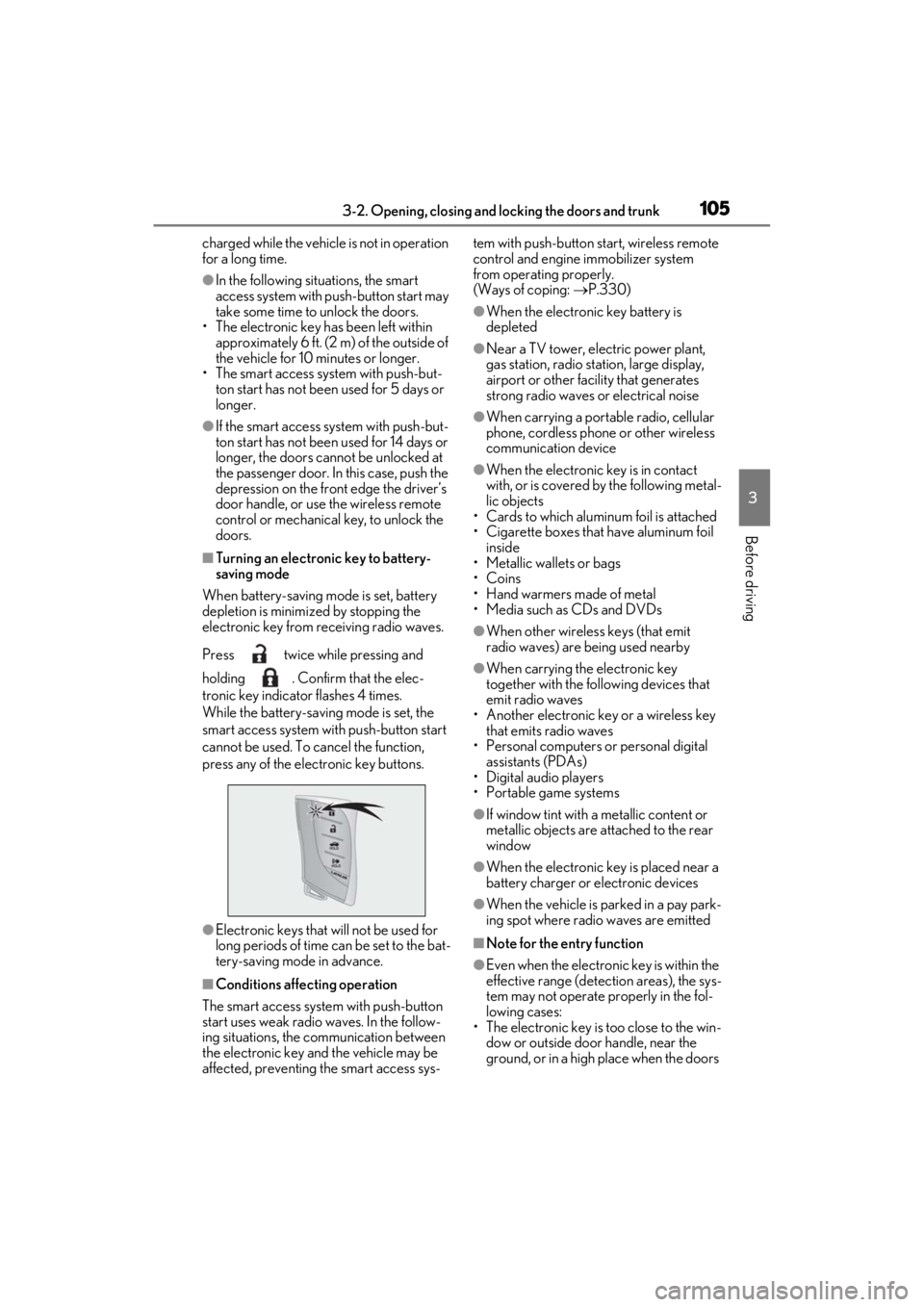
1053-2. Opening, closing and locking the doors and trunk
3
Before driving
charged while the vehicle is not in operation
for a long time.
●In the following situations, the smart
access system with pu sh-button start may
take some time to unlock the doors.
• The electronic key has been left within approximately 6 ft. (2 m) of the outside of
the vehicle for 10 minutes or longer.
• The smart access system with push-but- ton start has not been used for 5 days or
longer.
●If the smart access system with push-but-
ton start has not been used for 14 days or
longer, the doors cannot be unlocked at
the passenger door. In this case, push the
depression on the front edge the driver’s
door handle, or use the wireless remote
control or mechanical key, to unlock the
doors.
■Turning an electronic key to battery-
saving mode
When battery-saving mode is set, battery
depletion is minimized by stopping the
electronic key from receiving radio waves.
Press twice while pressing and
holding . Confirm that the elec-
tronic key indicator flashes 4 times.
While the battery-saving mode is set, the
smart access system with push-button start
cannot be used. To cancel the function,
press any of the electronic key buttons.
●Electronic keys that will not be used for
long periods of time can be set to the bat-
tery-saving mode in advance.
■Conditions affe cting operation
The smart access system with push-button
start uses weak radio waves. In the follow-
ing situations, the communication between
the electronic key and the vehicle may be
affected, preventing the smart access sys- tem with push-button start, wireless remote
control and engine immobilizer system
from operating properly.
(Ways of coping:
P.330)
●When the electronic key battery is
depleted
●Near a TV tower, electric power plant,
gas station, radio stat ion, large display,
airport or other fac ility that generates
strong radio waves or electrical noise
●When carrying a portable radio, cellular
phone, cordless phone or other wireless
communication device
●When the electronic key is in contact
with, or is covered by the following metal-
lic objects
• Cards to which aluminum foil is attached
• Cigarette boxes that have aluminum foil
inside
• Metallic wallets or bags
•Coins
• Hand warmers made of metal
• Media such as CDs and DVDs
●When other wireless keys (that emit
radio waves) are being used nearby
●When carrying the electronic key
together with the following devices that
emit radio waves
• Another electronic key or a wireless key that emits radio waves
• Personal computers or personal digital assistants (PDAs)
• Digital audio players
• Portable game systems
●If window tint with a metallic content or
metallic objects are attached to the rear
window
●When the electronic key is placed near a
battery charger or electronic devices
●When the vehicle is parked in a pay park-
ing spot where radio waves are emitted
■Note for the entry function
●Even when the electronic key is within the
effective range (detection areas), the sys-
tem may not operate properly in the fol-
lowing cases:
• The electronic key is too close to the win- dow or outside door handle, near the
ground, or in a high place when the doors
Page 109 of 410
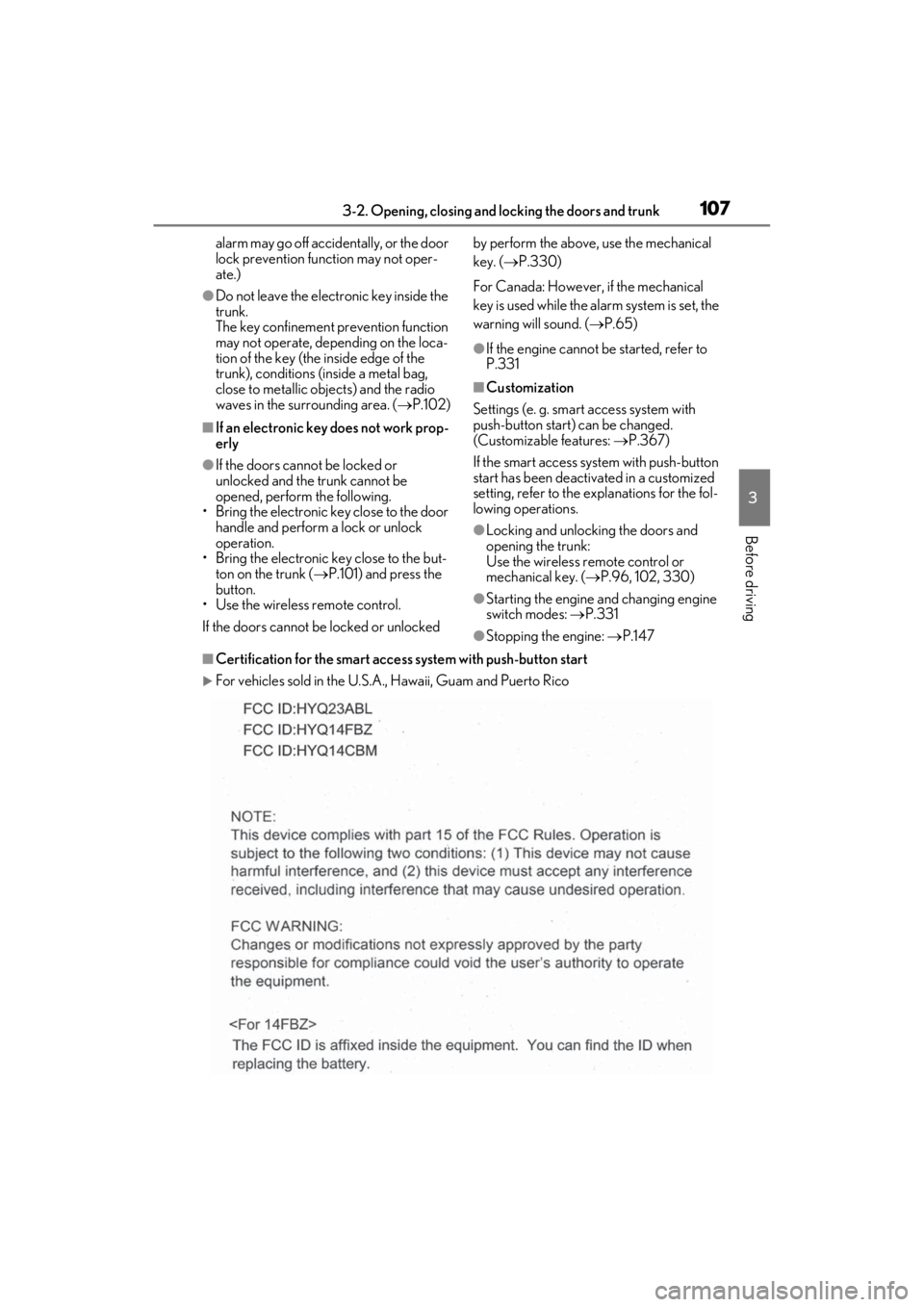
1073-2. Opening, closing and locking the doors and trunk
3
Before driving
alarm may go off accidentally, or the door
lock prevention function may not oper-
ate.)
●Do not leave the electronic key inside the
trunk.
The key confinement prevention function
may not operate, depending on the loca-
tion of the key (the inside edge of the
trunk), conditions (inside a metal bag,
close to metallic objects) and the radio
waves in the surrounding area. ( P.102)
■If an electronic key does not work prop-
erly
●If the doors cannot be locked or
unlocked and the trunk cannot be
opened, perform the following.
• Bring the electronic key close to the door
handle and perform a lock or unlock
operation.
• Bring the electronic key close to the but-
ton on the trunk ( P.101) and press the
button.
• Use the wireless remote control.
If the doors cannot be locked or unlocked by perform the above, use the mechanical
key. (
P.330)
For Canada: However, if the mechanical
key is used while the al arm system is set, the
warning will sound. ( P.65)
●If the engine cannot be started, refer to
P.331
■Customization
Settings (e. g. smart access system with
push-button start) can be changed.
(Customizable features: P.367)
If the smart access system with push-button
start has been deactivated in a customized
setting, refer to the explanations for the fol-
lowing operations.
●Locking and unloc king the doors and
opening the trunk:
Use the wireless remote control or
mechanical key. ( P.96, 102, 330)
●Starting the engine and changing engine
switch modes: P.331
●Stopping the engine: P.147
■Certification for the smart access system with push-button start
For vehicles sold in the U.S.A., Hawaii, Guam and Puerto Rico
Page 125 of 410

1233-5. Opening and closing the windows
3
Before driving
■Catch protection function
Window
If an object becomes caught between the
door and window while the window is open-
ing, window movement is stopped.
Rear quarter window
If an object becomes caught between the
rear quarter window an d vehicle body while
the rear quarter wind ow is opening, win-
dow movement is stopped.
■When the window cannot be opened or
closed
When the jam protection function or catch
protection function op erates unusually and
the door window cannot be opened or
closed, perform the following operations
with the power window switch of that door.
●Stop the vehicle. With the engine switch
in ON, within 4 seconds of the jam pro-
tection function or catch protection func-
tion activating, continuously operate the
power window switch in the one-touch
closing direction or one-touch opening
direction so that the door window can be
opened and closed.
●If the door window cannot be opened
and closed even when performing the
above operations, perform the following
procedure for function initialization.
1 Close both side doors.
2 Turn the engine switch to ON.
3 Close the soft top roof, and then close
the side windows an d rear quarter win-
dows.
4 Pull and hold the power window switch
in the one-touch closing direction for
approximately 6 seconds or more.
5 Press and hold the power window
switch in the one-touch opening direc-
tion. After the door window is com-
pletely opened, continue holding the
switch for an additional 1 second or
more.
6 Release the power window switch for a
moment, resume push ing the switch in
the one-touch opening direction, and
hold it there for approximately 4 sec-
onds or more. 7
Pull and hold the power window switch
in the one-touch closing direction
again. After the door window is com-
pletely closed, continue holding the
switch for a further 1 second or more.
If you release the switch while the window is
moving, start again from the beginning.
If the window reverses and cannot be fully
closed or opened, have the vehicle
inspected by your Lexus dealer.
■When the rear quarter windows cannot
be opened or closed
When the jam protection function or catch
protection function operates unusually and
the rear quarter wind ow cannot be opened
or closed, perform the following operations
with the all window control switch.
●Stop the vehicle. With the engine switch
in ON, within 4 seconds of the jam pro-
tection function or catch protection func-
tion activating, continuously operate the
all window control switch in the closing
direction or one-touc h opening direction
so that the rear quarter window can be
opened and closed.
●If the rear quarter window cannot be
opened and closed even when perform-
ing the above operations, perform the
following procedure for function initial-
ization.
1 Close both side doors.
2 Turn the engine switch to ON.
3 Close the soft top roof, and then close
the side windows.
4 Pull and hold the all window control
switch in the closing direction for
approximately 6 seconds or more.
5 Press and hold the all window control
switch in the one-touch opening direc-
tion. After the side windows and rear
quarter windows are completely
opened, continue holding the switch for
an additional 1 second or more.
6 Release the all window control switch
for a moment, resume pressing and
holding the switch in the one-touch
opening direction for approximately 4
seconds or more.
Page 129 of 410

1273-6. Opening and closing the soft top roof
3
Before driving
Opening/closing status of the soft top roof
will be displayed on the multi-information
display.
When the operation of the soft top roof has
completed, the bar will turn to gray and the
buzzer will sound.
To close the side windows and rear quarter
windows, press the power window switch.
( P.122)
■Operational conditions
●The vehicle speed is less than approxi-
mately 31 mph (50 km/h) (However, it is
recommended that the soft top roof is
opened or closed when the vehicle is
stopped.)
●The engine is running (The soft top roof
can operate with the engine switch in
ON, however, in order to prevent battery
discharge, it is recommended to start the
engine.)
●The trunk lid is closed
■Situations in which the soft top roof
operation stops partway
In the following situation, operation of the
soft top roof stops partway.
●When releasing the roof switch while the
soft top roof is operating
●The vehicle speed is approximately 31
mph (50 km/h) or higher.
●If there is a malfunction in the system
●When operate the soft top roof repeat-
edly in a short period of time
●If the battery is discharged
■Situations in which the soft top roof may
not operate properly
In the following situation, the soft top roof
may not operate properly.
●When the jam protection function or
catch protection function of the power
windows operates
●When starting the en gine while operating
the roof switch (The so ft top roof that is
operating stops partway or returns to the
previous position.)
●If the roof switch has not been operated
for a long period of time during the oper-
ation of the soft top roof. (“Soft Top
Operation Not Completed Soft Top Will
Move Soon” is displayed on the multi-
information display for approximately 10
seconds, and then the soft top will move
slowly.)
●When the roof switch is operated on a
steep incline or large step
●When driving on uneven road surfaces
●In strong wind
■Switch operation when the operational
conditions are not met
If the soft top roof is fully closed and the
vehicle is stopped, continuously operating
the roof switch can operate the side win-
dows and rear quarter windows only even if
the operational conditions of the soft top
roof are not met
■While the soft top roof is operating
●The trunk opener switch cannot be oper-
ated. Press the switch after the operation
of the soft top roof has been completed.
( P.101)
●The side windows and rear quarter win-
dows cannot be operated using the
power window switch or all window con-
trol switch. They can be operated when
the soft top roof operation partway stops,
however, they cannot be fully closed.
■If water splashes on the soft top roof,
such as in the rain or in a car wash
Wipe away any water before opening the
soft top roof. To prevent wrinkles, it is rec-
ommended to open the soft top roof after it
has completely dried.
■Soft top roof open warning buzzer
A buzzer sounds if opening or closing the
soft top roof is not completed. Open or
close the soft top roof as soon as possible.
■If a battery terminal has been discon-
nected and reconnected
If “Soft Top Operation Not Completed” is
displayed on the multi-information display
after the engine has been started, perform
the following procedure.
Page 130 of 410

1283-6. Opening and closing the soft top roof
When the soft top roof of the rear win-
dow side stops near the fully closing posi-
tion.
1 Operate the roof switch to open the
soft top roof, and release the switch with
the luggage cover opened.
2 Operate the roof switch to fully close
the soft top roof.
When the rear soft top roof stops near
the fully opening position.
Operate the roof switch to fully close the soft top roof.
If the luggage cover does not operate by
performing the procedure above, check
that a warning message is displayed on the
multi-information display or the operational
conditions are met. If
the luggage cover still
does not operate, have the vehicle
inspected by your Lexus dealer.
■If the soft top roof cannot be operated properly when the roof switch is operated
In the following situations, perform the actions specified in the table, and then operate the
switch again.
●Soft top roof operation stops partway
SituationWarning messageAction
The engine switch is
turned to OFF or
ACC while the soft
top roof is operating.
-Start the engine, or turn the engine switch
to ON, and then operate the roof switch.
The vehicle speed
exceeds approxi-
mately 31 mph (50
km/h) while the soft
top roof is operating.
“SLOW DOWN to
Compelete Soft Top
Operation”Decelerate to approximately 31 mph (50
km/h), and then operate the roof switch.
The trunk lid is
opened using the
mechanical key while
the soft top roof is
operating.
-Close the trunk lid, and then operate the
roof switch.
A collision is
detected.-Contact your Lexus dealer.
The catch protection
function of a power
window is activated.
- P.123
The soft top roof is
operated manually.
“SLOW DOWN to
Compelete Soft Top
Operation”
“Soft Top Operation
Not Completed”Manually return the soft top roof to the
previous position. If the soft top roof cannot
be operated, repeat opening and closing
operations several times.
Page 131 of 410
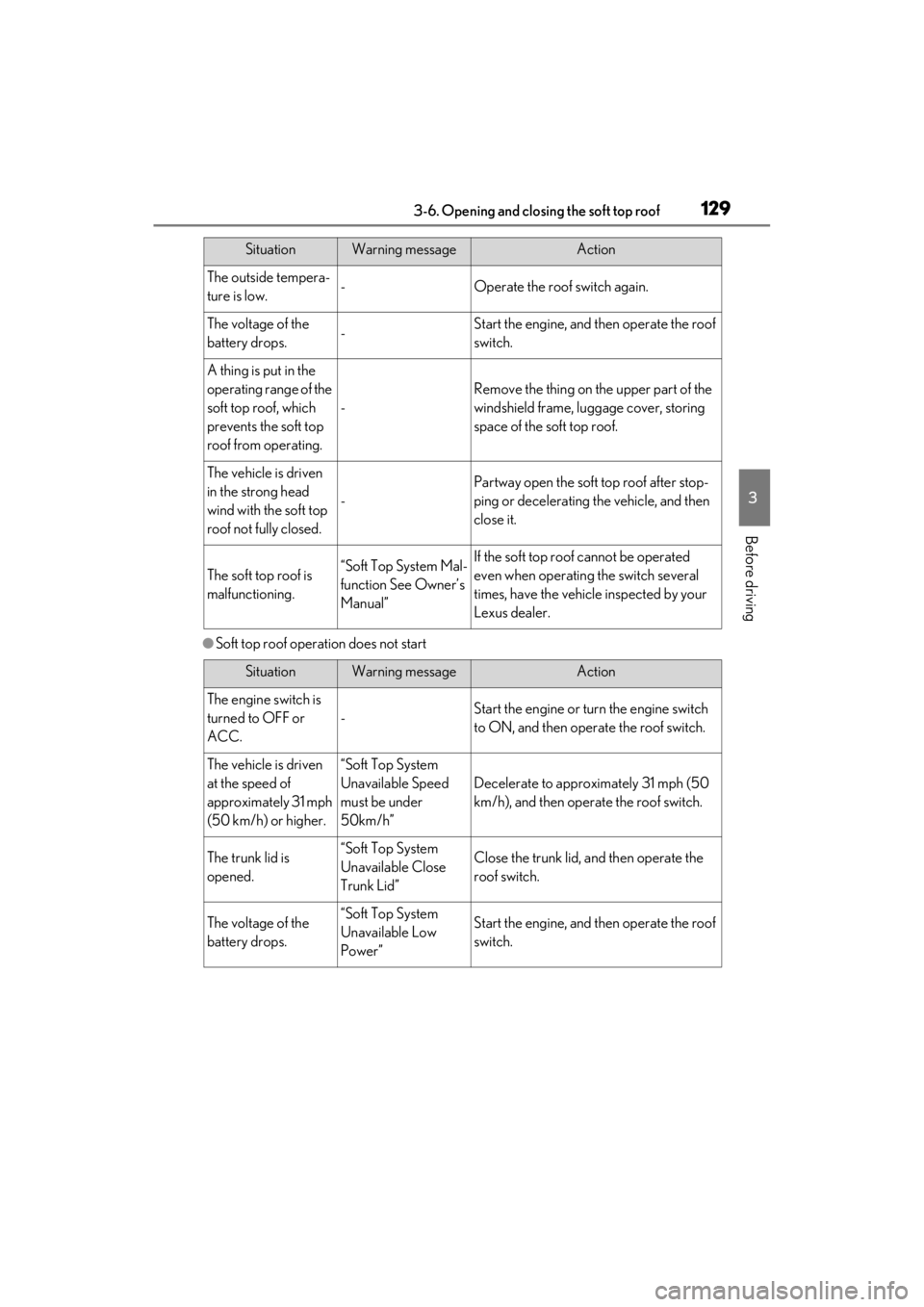
1293-6. Opening and closing the soft top roof
3
Before driving
●Soft top roof operation does not start
The outside tempera-
ture is low.-Operate the roof switch again.
The voltage of the
battery drops.-Start the engine, and then operate the roof
switch.
A thing is put in the
operating range of the
soft top roof, which
prevents the soft top
roof from operating.
-
Remove the thing on the upper part of the
windshield frame, luggage cover, storing
space of the soft top roof.
The vehicle is driven
in the strong head
wind with the soft top
roof not fully closed.
-
Partway open the soft top roof after stop-
ping or decelerating the vehicle, and then
close it.
The soft top roof is
malfunctioning.“Soft Top System Mal-
function See Owner’s
Manual”If the soft top roof cannot be operated
even when operating the switch several
times, have the vehicle inspected by your
Lexus dealer.
SituationWarning messageAction
The engine switch is
turned to OFF or
ACC.
-Start the engine or tu rn the engine switch
to ON, and then operate the roof switch.
The vehicle is driven
at the speed of
approximately 31 mph
(50 km/h) or higher.“Soft Top System
Unavailable Speed
must be under
50km/h”
Decelerate to approximately 31 mph (50
km/h), and then operate the roof switch.
The trunk lid is
opened.“Soft Top System
Unavailable Close
Trunk Lid”Close the trunk lid, and then operate the
roof switch.
The voltage of the
battery drops.“Soft Top System
Unavailable Low
Power”Start the engine, and then operate the roof
switch.
SituationWarning messageAction
Page 134 of 410
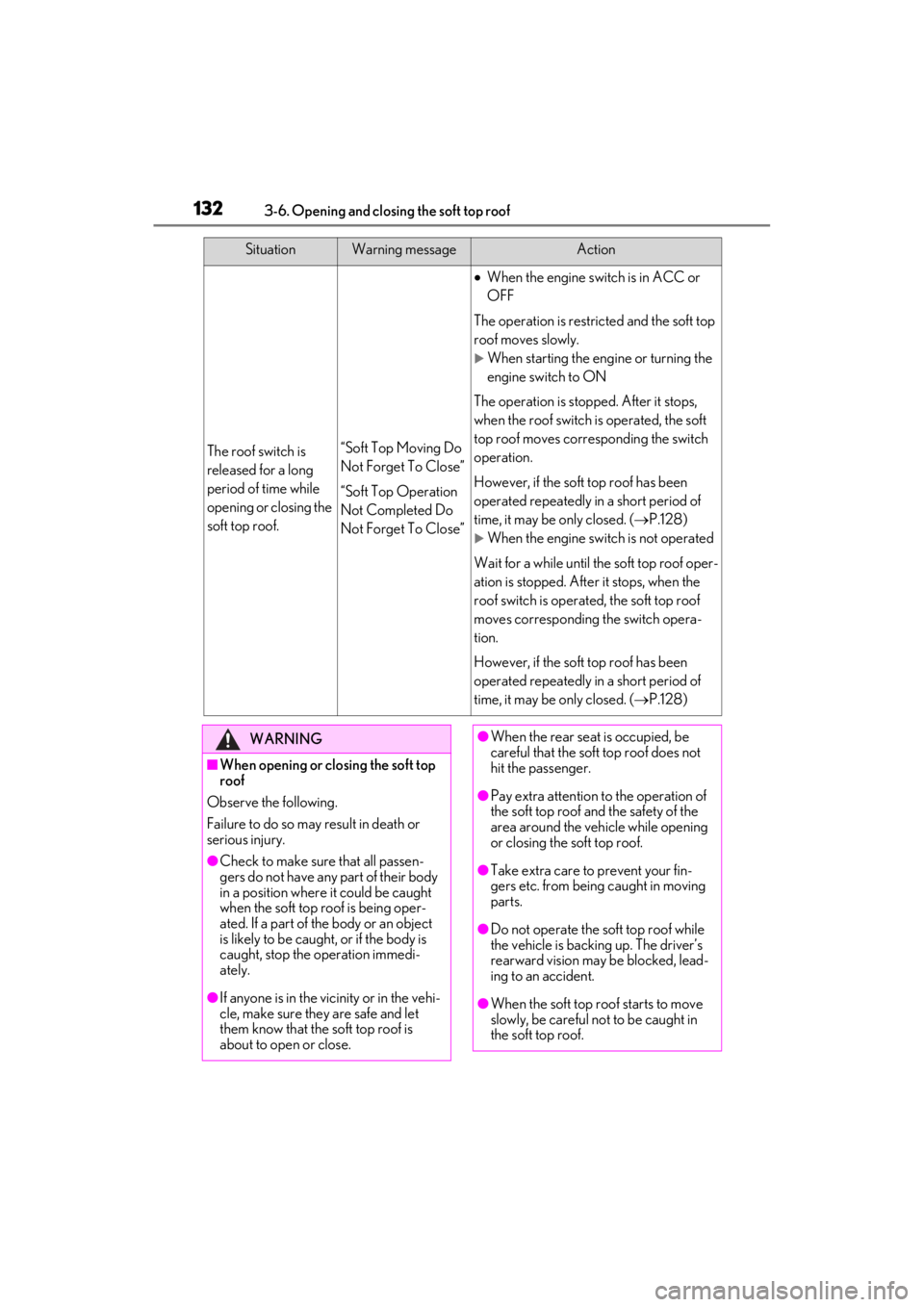
1323-6. Opening and closing the soft top roof
The roof switch is
released for a long
period of time while
opening or closing the
soft top roof.“Soft Top Moving Do
Not Forget To Close”
“Soft Top Operation
Not Completed Do
Not Forget To Close”
When the engine switch is in ACC or
OFF
The operation is restricted and the soft top
roof moves slowly.
When starting the engine or turning the
engine switch to ON
The operation is stoppe d. After it stops,
when the roof switch is operated, the soft
top roof moves corresponding the switch
operation.
However, if the soft top roof has been
operated repeatedly in a short period of
time, it may be only closed. ( P.128)
When the engine switch is not operated
Wait for a while until the soft top roof oper-
ation is stopped. After it stops, when the
roof switch is operated, the soft top roof
moves corresponding the switch opera-
tion.
However, if the soft top roof has been
operated repeatedly in a short period of
time, it may be only closed. ( P.128)
SituationWarning messageAction
WARNING
■When opening or closing the soft top
roof
Observe the following.
Failure to do so may result in death or
serious injury.
●Check to make sure that all passen-
gers do not have any part of their body
in a position where it could be caught
when the soft top roof is being oper-
ated. If a part of the body or an object
is likely to be caught, or if the body is
caught, stop the operation immedi-
ately.
●If anyone is in the vi cinity or in the vehi-
cle, make sure they are safe and let
them know that the soft top roof is
about to open or close.
●When the rear seat is occupied, be
careful that the soft top roof does not
hit the passenger.
●Pay extra attention to the operation of
the soft top roof and the safety of the
area around the vehicle while opening
or closing the soft top roof.
●Take extra care to prevent your fin-
gers etc. from being caught in moving
parts.
●Do not operate the soft top roof while
the vehicle is backing up. The driver’s
rearward vision may be blocked, lead-
ing to an accident.
●When the soft top roof starts to move
slowly, be careful no t to be caught in
the soft top roof.
Page 138 of 410
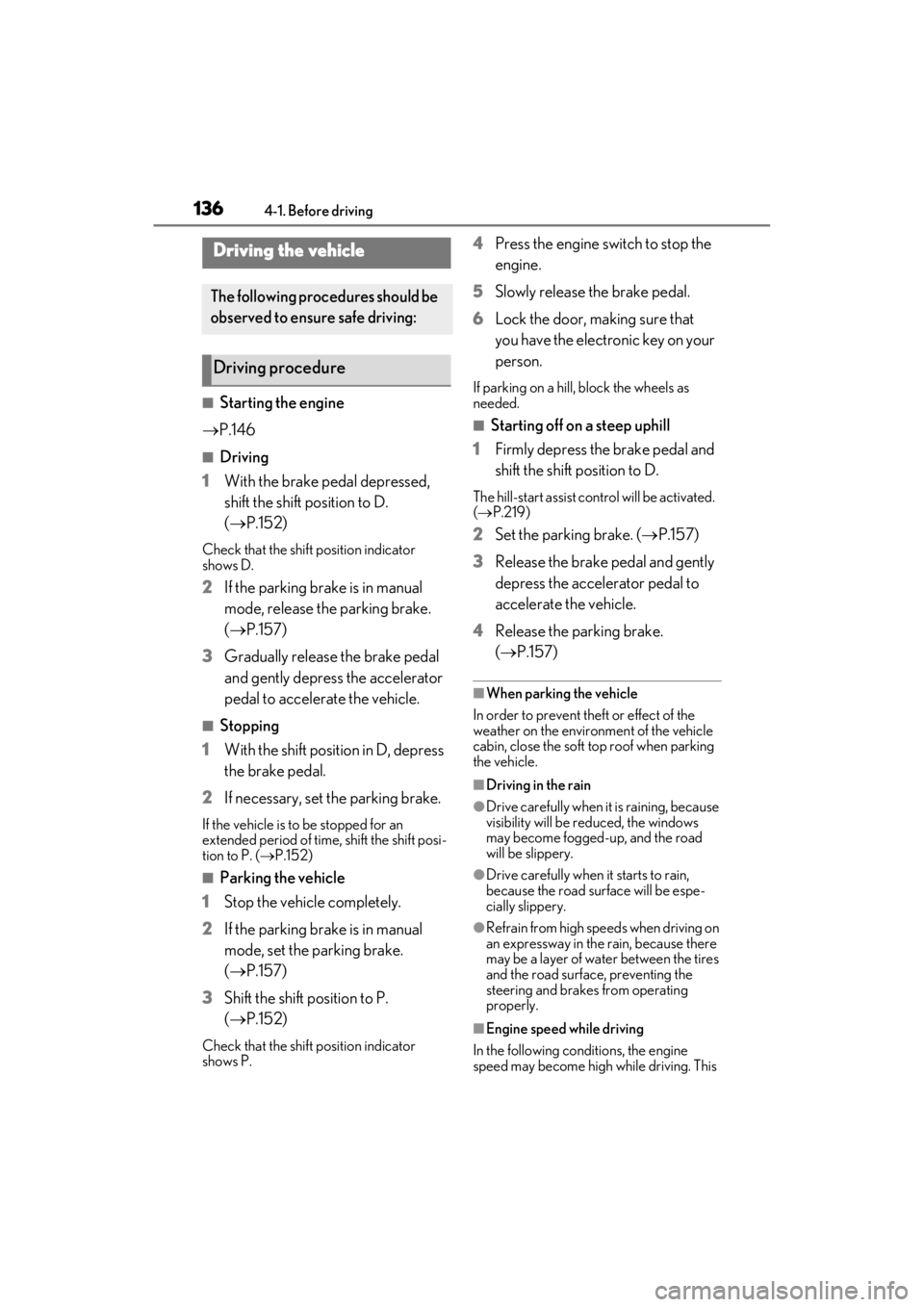
1364-1. Before driving
4-1.Before driving
■Starting the engine
P.146
■Driving
1 With the brake pedal depressed,
shift the shift position to D.
(P.152)
Check that the shift position indicator
shows D.
2 If the parking brake is in manual
mode, release the parking brake.
(P.157)
3 Gradually release the brake pedal
and gently depress the accelerator
pedal to accelerate the vehicle.
■Stopping
1 With the shift position in D, depress
the brake pedal.
2 If necessary, set the parking brake.
If the vehicle is to be stopped for an
extended period of time, shift the shift posi-
tion to P. ( P.152)
■Parking the vehicle
1 Stop the vehicle completely.
2 If the parking brake is in manual
mode, set the parking brake.
(P.157)
3 Shift the shift position to P.
(P.152)
Check that the shift position indicator
shows P.
4 Press the engine switch to stop the
engine.
5 Slowly release the brake pedal.
6 Lock the door, making sure that
you have the electronic key on your
person.
If parking on a hill, block the wheels as
needed.
■Starting off on a steep uphill
1 Firmly depress the brake pedal and
shift the shift position to D.
The hill-start assist control will be activated.
( P.219)
2 Set the parking brake. ( P.157)
3 Release the brake pedal and gently
depress the accelerator pedal to
accelerate the vehicle.
4 Release the parking brake.
(P.157)
■When parking the vehicle
In order to prevent theft or effect of the
weather on the environment of the vehicle
cabin, close the soft top roof when parking
the vehicle.
■Driving in the rain
●Drive carefully when it is raining, because
visibility will be reduced, the windows
may become fogged-up, and the road
will be slippery.
●Drive carefully when it starts to rain,
because the road surface will be espe-
cially slippery.
●Refrain from high speeds when driving on
an expressway in the rain, because there
may be a layer of wa ter between the tires
and the road surface, preventing the
steering and brakes from operating
properly.
■Engine speed while driving
In the following conditions, the engine
speed may become high while driving. This
Driving the vehicle
The following procedures should be
observed to ensure safe driving:
Driving procedure
Page 139 of 410
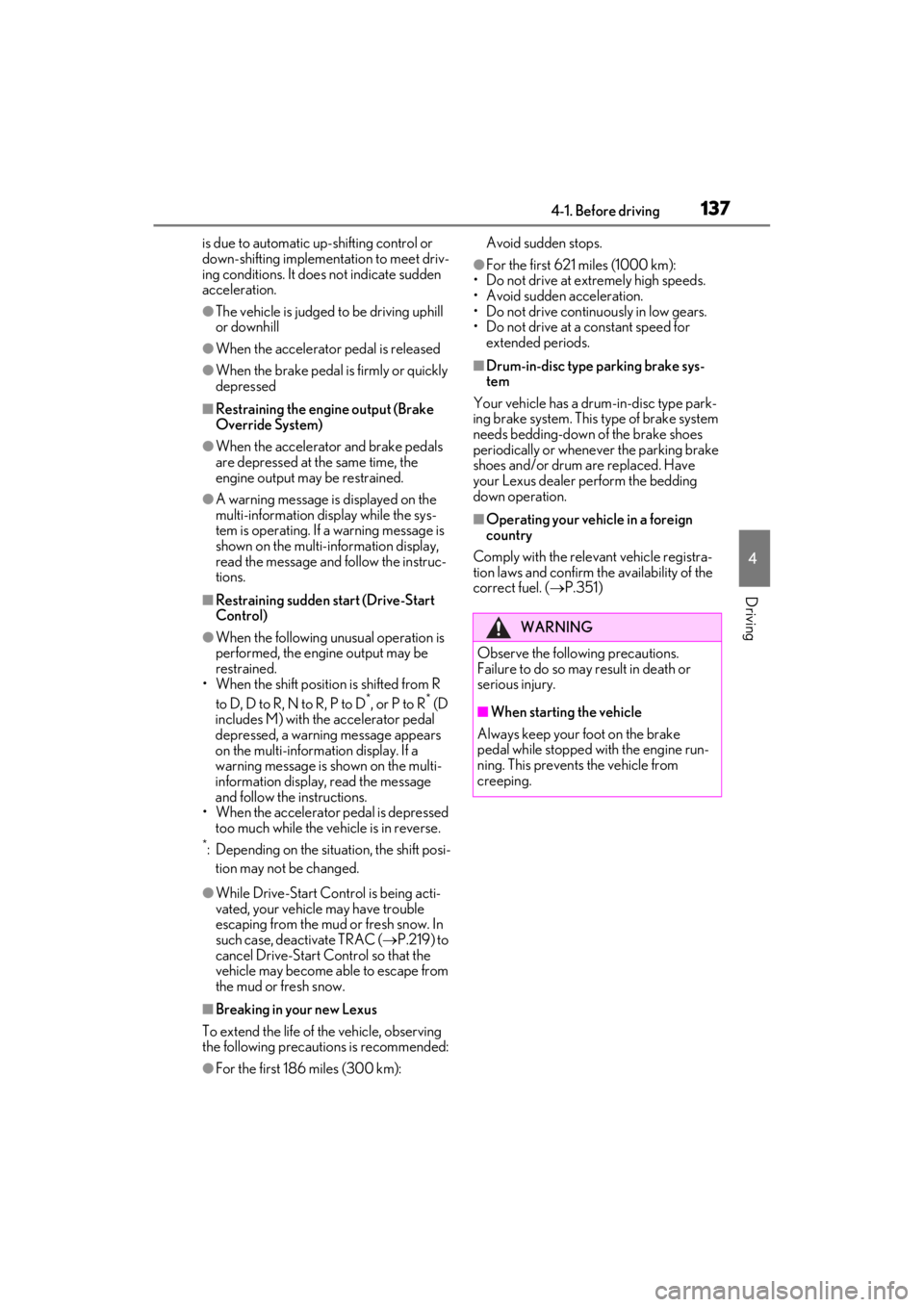
1374-1. Before driving
4
Driving
is due to automatic up-shifting control or
down-shifting implementation to meet driv-
ing conditions. It does not indicate sudden
acceleration.
●The vehicle is judged to be driving uphill
or downhill
●When the accelerator pedal is released
●When the brake pedal is firmly or quickly
depressed
■Restraining the engine output (Brake
Override System)
●When the accelerator and brake pedals
are depressed at the same time, the
engine output may be restrained.
●A warning message is displayed on the
multi-information display while the sys-
tem is operating. If a warning message is
shown on the multi-information display,
read the message and follow the instruc-
tions.
■Restraining sudden start (Drive-Start
Control)
●When the following unusual operation is
performed, the engine output may be
restrained.
• When the shift position is shifted from R
to D, D to R, N to R, P to D
*, or P to R* (D
includes M) with the accelerator pedal
depressed, a warning message appears
on the multi-information display. If a
warning message is shown on the multi-
information display, read the message
and follow the instructions.
• When the accelerator pedal is depressed
too much while the vehicle is in reverse.
*: Depending on the situation, the shift posi-
tion may not be changed.
●While Drive-Start Control is being acti-
vated, your vehicle may have trouble
escaping from the mud or fresh snow. In
such case, deactivate TRAC ( P.219) to
cancel Drive-Start Control so that the
vehicle may become able to escape from
the mud or fresh snow.
■Breaking in your new Lexus
To extend the life of the vehicle, observing
the following precautions is recommended:
●For the first 186 miles (300 km): Avoid sudden stops.
●For the first 621 miles (1000 km):
• Do not drive at extremely high speeds.
• Avoid sudden acceleration.
• Do not drive continuously in low gears.
• Do not drive at a constant speed for extended periods.
■Drum-in-disc type parking brake sys-
tem
Your vehicle has a drum-in-disc type park-
ing brake system. This type of brake system
needs bedding-down of the brake shoes
periodically or whenever the parking brake
shoes and/or drum are replaced. Have
your Lexus dealer perform the bedding
down operation.
■Operating your vehicle in a foreign
country
Comply with the relevant vehicle registra-
tion laws and confirm the availability of the
correct fuel. ( P.351)
WARNING
Observe the following precautions.
Failure to do so may result in death or
serious injury.
■When starting the vehicle
Always keep your foot on the brake
pedal while stopped with the engine run-
ning. This prevents the vehicle from
creeping.
Page 142 of 410
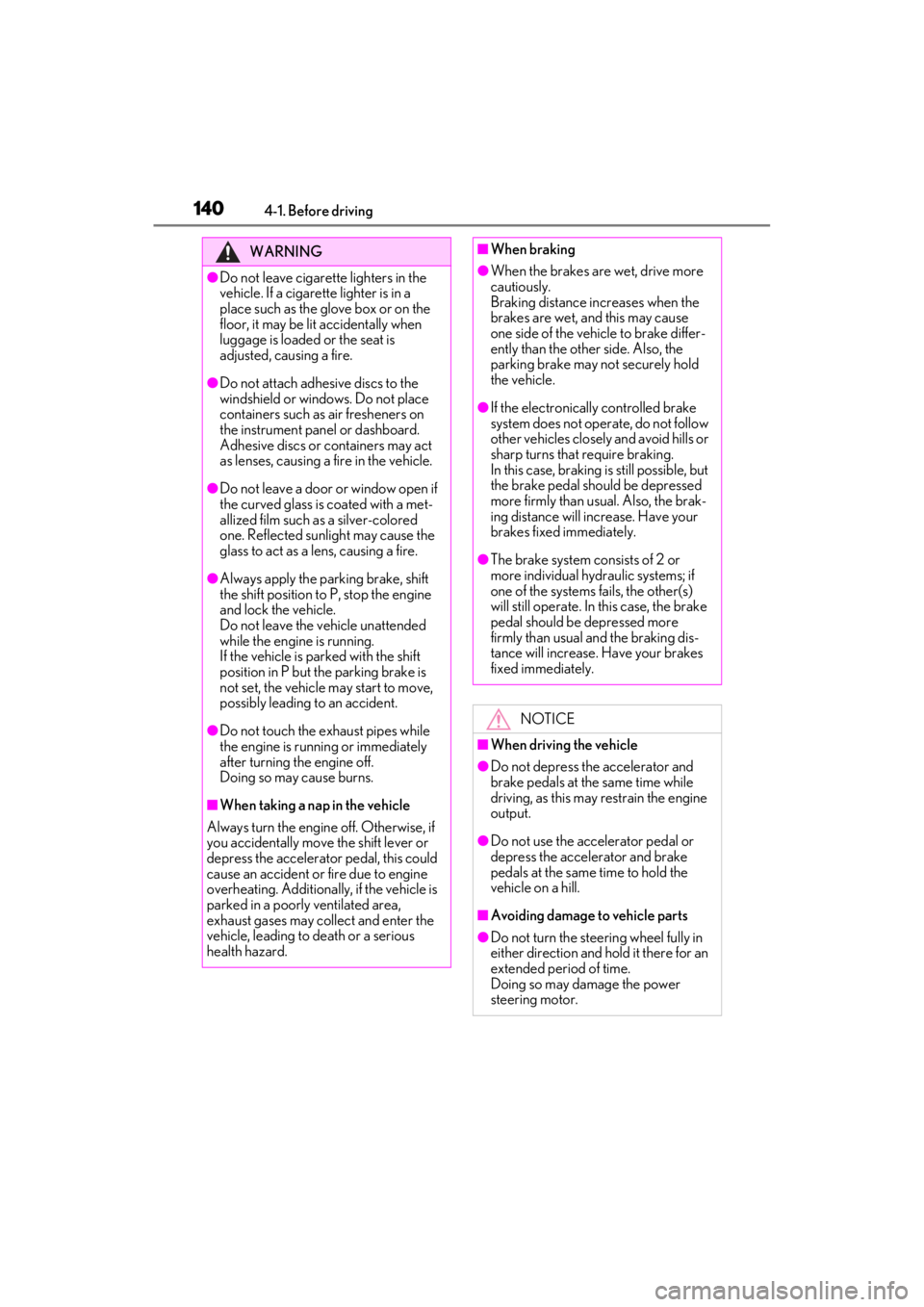
1404-1. Before driving
WARNING
●Do not leave cigarette lighters in the
vehicle. If a cigarette lighter is in a
place such as the glove box or on the
floor, it may be lit accidentally when
luggage is loaded or the seat is
adjusted, causing a fire.
●Do not attach adhesive discs to the
windshield or windows. Do not place
containers such as air fresheners on
the instrument panel or dashboard.
Adhesive discs or containers may act
as lenses, causing a fire in the vehicle.
●Do not leave a door or window open if
the curved glass is coated with a met-
allized film such as a silver-colored
one. Reflected sunlight may cause the
glass to act as a lens, causing a fire.
●Always apply the parking brake, shift
the shift position to P, stop the engine
and lock the vehicle.
Do not leave the vehicle unattended
while the engine is running.
If the vehicle is parked with the shift
position in P but the parking brake is
not set, the vehicle may start to move,
possibly leading to an accident.
●Do not touch the exhaust pipes while
the engine is running or immediately
after turning the engine off.
Doing so may cause burns.
■When taking a nap in the vehicle
Always turn the engine off. Otherwise, if
you accidentally move the shift lever or
depress the accelerator pedal, this could
cause an accident or fire due to engine
overheating. Additionally, if the vehicle is
parked in a poorly ventilated area,
exhaust gases may collect and enter the
vehicle, leading to death or a serious
health hazard.
■When braking
●When the brakes are wet, drive more
cautiously.
Braking distance in creases when the
brakes are wet, and this may cause
one side of the vehicle to brake differ-
ently than the other side. Also, the
parking brake may not securely hold
the vehicle.
●If the electronically controlled brake
system does not operate, do not follow
other vehicles closely and avoid hills or
sharp turns that require braking.
In this case, braking is still possible, but
the brake pedal should be depressed
more firmly than usual. Also, the brak-
ing distance will increase. Have your
brakes fixed immediately.
●The brake system consists of 2 or
more individual hydraulic systems; if
one of the systems fails, the other(s)
will still operate. In this case, the brake
pedal should be depressed more
firmly than usual and the braking dis-
tance will increase. Have your brakes
fixed immediately.
NOTICE
■When driving the vehicle
●Do not depress the accelerator and
brake pedals at th e same time while
driving, as this may restrain the engine
output.
●Do not use the accelerator pedal or
depress the accelerator and brake
pedals at the same time to hold the
vehicle on a hill.
■Avoiding damage to vehicle parts
●Do not turn the steering wheel fully in
either direction and hold it there for an
extended period of time.
Doing so may damage the power
steering motor.